Meagan Pollock Encourages CISTEME365 Educators to Reach and Teach Every Student
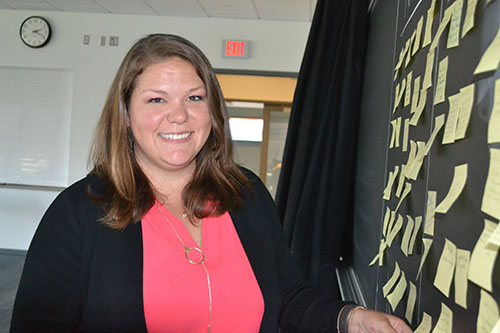
Meagan Pollock examines teachers’ notes of their aha moments during Pollock’s training.
September 4, 2019
As part of the NSF grant, Catalyzing Inclusive STEM Experiences All Year Round (CISTEME365), 16 teachers from five schools visited Illinois for the first CISTEME365 Institute. Their goal was to receive training needed to begin after-school STEM clubs in their schools. Because CISTEME365 is targeting students often underserved in STEM, including women and minorities, the first week’s emphasis was equity training taught by Meagan Pollock of the National Alliance for Partnerships in Equity (NAPE). The message of the week-long institute was simple: reach and teach every student.
According to Lynford Goddard, Electrical and Computer Engineering (ECE) Professor and PI of the grant, their collaboration with NAPE came about because the organization works with school officials to promote access and equity in their classrooms and is an NSF-funded, scientifically-proven effective strategy whose past work shows how effective this type of program is.
Thus, during the two-week institute from July 22–August 3, 2019, five Idea Teams comprised of 2-4 educators from each school received training in order to begin their STEM clubs to expose underserved students to STEM. The first week the educators learned about equity from Meagan Pollock of NAPE, while the second week exposed educators to the nuts and bolts—hands-on activities that could potentially be used as programming for their clubs.
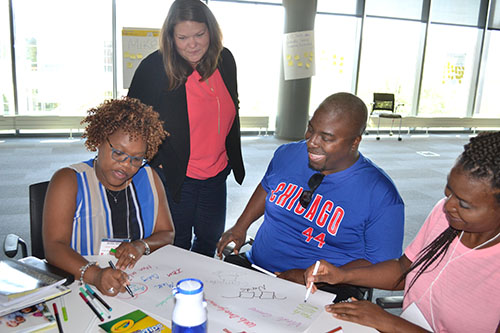
Meagan Pollock (second from the left, watches educators work on their poster regarding what students perceive STEM to be.
Pollock’s goal was to introduce educators at the institute to the “basic principles of educational equity, with the ultimate goal of not only improving student success, but equipping their students to be interested in and hopefully pursue careers and pathways within science, technology, engineering and math.” She says one key topic they addressed was “’How do we meet the needs of our students, especially the females and the students of color?’ so that we can help those students who are on the margins feel like these are careers and pathways that are for them.”
According to Pollock, Monday’s instruction focused on bias: “How to understand implicit bias,” she explains, “the unconscious bias that each and every one of us hold, and how these biases affect how we interact with, not only one another, but with our students.”
To further demonstrate what unconscious bias is, Pollock led an activity intended to help participants, “understand who they are, and who their identity is, and how that influences their perspective on the world.” So she gave them an example: herself. She moves through this world as a white woman raised in a lower middle class family: “So that frames my entire experience, and how I look at the world,” she admits. “And so we talk about who you are and how that affects your lens.”
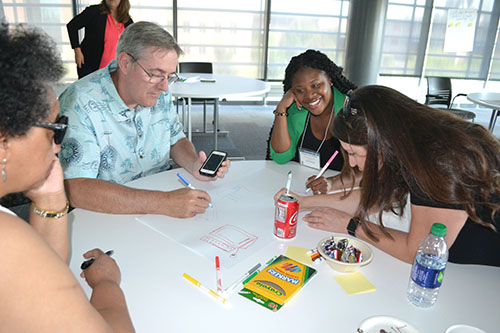
Zenobia Jefferson, Terry Koker, Stephanie Miller, and Irica Baurer work on their poster about students' perceptions of STEM.
Next, she had participants talk about who’s in their world, the top 10 people they hang out with and are close to, and their characteristics. “So it really helps us to understand how we may have some biases that we may not realize that really shape how we look at the world, right?”
She also introduced different scenarios where they examined how biases manifest in really subtle ways: “Usually when I teach this—always when I teach this,” she qualifies, “there are people who say, ‘Oh, I don't have bias. I'm a good person.’ And we never argue that. ‘Yes, you can be a good person,’ she agrees. ‘However, if you have a brain, you have bias!’”
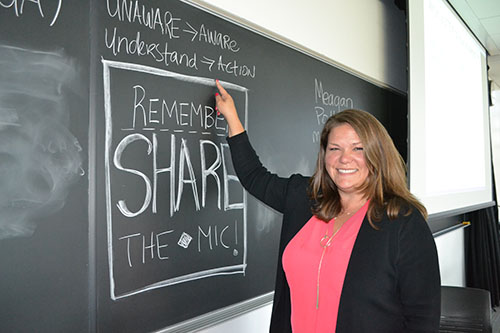
Meagan Pollock indicates the U->A Continuum.
She says one of the biggest things teachers as people have to overcome is owning to this fact: “We are all complicit in these kinds of biases that affect our students. And so our goal when we do this work is to really shine a light on some things that people aren't always, or perhaps ever, thinking about.”
In a prominent spot on the blackboard was the succinct message and overall goal of the week—an awareness continuum she calls “U->A Squared.” She explains. “Our goal is to move people from a position of being unaware to aware. But that's not enough. We need to get to this place of understanding and then, ultimately, action. And so we use this phrase: ‘U->A Squared.’ This is so critical, because it's not enough to just be aware. It's not enough to just understand that your experience is different than mine. We have to change and do something different.”
She claims the scaffold of the week is moving institute participants along this continuum of awareness from understanding to action: “And, ultimately, what are we going to do that's going to transform who we are and how we engage with students and in the classroom?”
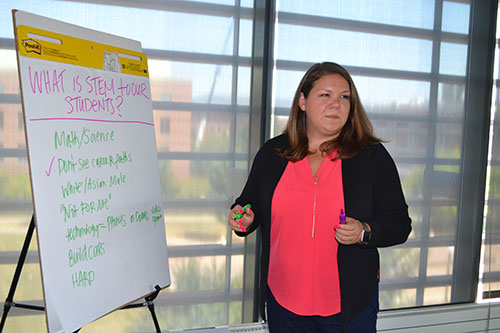
Meagan Pollock creates a list of what educators believe their students think of as STEM.
One relevant activity that she had the educators do that she felt really engaged them and was really effective in terms of communicating the instruction was related to STEM careers, specifically, “overcoming some of the stereotypes and biases that we hold, and that our students hold, and how that affects their choice.”
So she had the educators draw a picture of what their students think about STEM careers. Then they looked at the influences of technology, then ended the activity by drawing another picture of the skills and qualities needed in these professions. Finally, they were to compare and contrast what STEM careers need to what their students think. “And it's really big delta,” she admits. “And so it gives some of the biggest aha moments of, ‘So, how do we change what we're doing to help students see the difference between what they think and what is really needed?’” She says the activity really brought together all the things that they had talked about around implicit bias, and micro messaging, self-efficacy, and some of the other concepts around mindset and stereotypes threat as well.
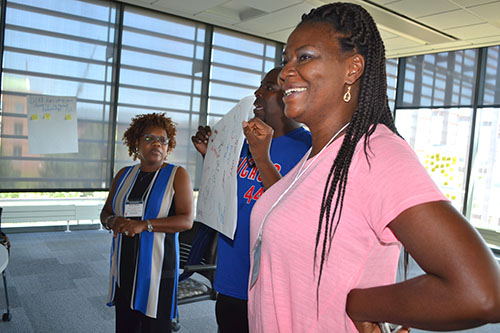
Lillian Perteete (right), a counselor at Chicago Vocational Career Academy and her teammates present their poster on students’ perception of STEM.
According to Pollock, one thing about her curriculum that’s different from others is that it starts from a positive tack: “‘Every educator I've ever worked with has always intended good on their students, right? And we all want our students to succeed.’ And so we start there, which is really different.” She thinks they have a greater advantage because they, “sort of ease into those conversations.” Other curricula start from a deficit place: “You’re racist, or sexist, or homophobic,” but says starting a conversation from that deficit ideology doesn't usually work. “So we come in saying, ‘Hey, we all agree we want our students to succeed,’ and then go from there. And so we sort of backdoor into some of the harder conversations around race and gender and class.”
Has Pollock experienced teaching her materials and saying something, and right then and there, a person’s eyes are opened up to the understanding that they have this really strong bias that's holding their students back? She says it isn’t often that she gets to see that kind of change, because of the really short amount of time she normally has with a person. “It's so rare that I get to see a full light switch turn on and be like, ‘Wow, I looked at the world the entirely wrong way from the hole for so long.’”
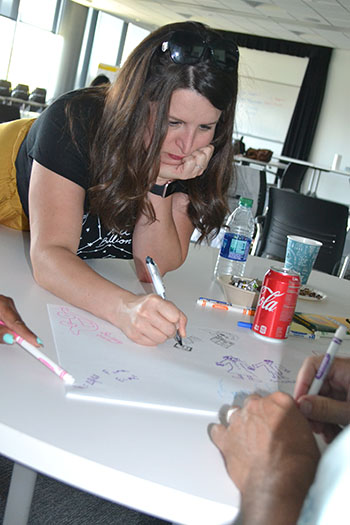
Irica Baurer, a Fine Arts Teacher at Sarah E. Goode STEM Academy, works on her team’s poster depicting students’ perception of what STEM is.
So for training sessions, her goal is just: “I plant a seed, or I give them a flashlight that they start turning on and off to see where these start showing up, and they see change over time,” she explains, adding, “I just get to scaffold an activity and then hope that they take that and continue to reflect on our work, and maybe look at the world differently.”
She also acknowledges that, because her part of the CISTEME365 institute is only for one week, the teachers are getting a lot of information at once. “The most successful interventions I've done have been PD over the course of a year,” she claims. “So that growth is much more significant because they're getting dosed along the way. And so then I can see an individual's growth because of these regular doses and interventions.”
According to Pollock, NAPE has validated that longer term engagements with people produce the most success. “And that's kind of logical, right? Keep being reminded,” Pollock says. However, it’s not only being reminded. She says it's being “engaged in a community of people who you now have built a shared language with and that you get to go back and work with and continue to support one another in the work and the journey. And so, that's always going to be more successful than a one-hour workshop.”
Fortunately, CISTEME365 is set up in such a way that the educators are both part of a community and reminded periodically. The educators are part of school Idea Teams that will serve to constantly encourage one another. Plus, Pollock is going to have that additional time with these teachers, meeting with them monthly to check in to see how they're progressing on their goals of applying this work, as well as their goals of building the after-school STEM club that they learned about during the second week of the institute. “And so I'm excited and hopeful to see how we can work together over the next year,” she says.
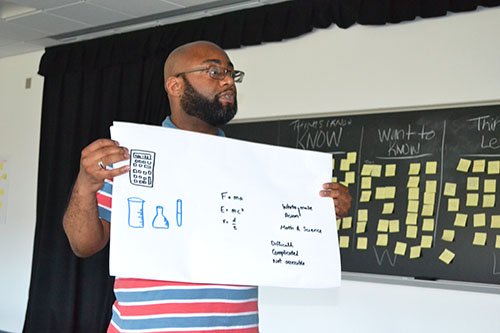
Vernon Rogers, the Sarah E Goode STEM Academy Diverse Learner Teacher, presents his team’s comparison of STEM careers vs. students’ skills.
The CISTEME365 educators had several takeaways from Pollock’s training they intended to put into practice in their schools. For instance, Lemond Peppers, a Student Engagement Advocate from Urbana High School, intends to communicate to his students the word "yet" (they have time yet), and that they can do it. “I’m going to take the power of yet to my students, that ‘You don't have to be there right now, but there's that “yet,” you still can get this; this is still available to you. It's yet available. And just really honing in on self-efficacy that, ‘I can!’ That you can be more than the images that are broadcast, that you can do more than what's happening in your neighborhood. And STEM curriculum as a way to achieve that.”
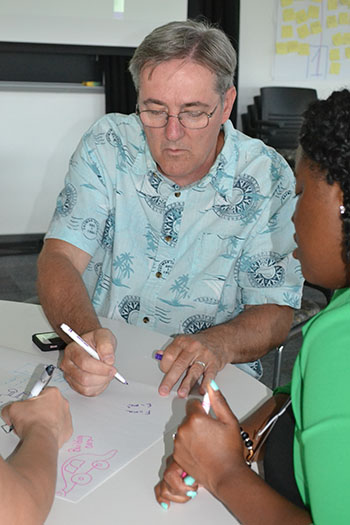
Terry Koker, Mahomet-Seymour chemistry teacher.
Unable to attend the equity institute the first week, Donnell White, the sixth grade math teacher and International Baccalaureate Coordinator for sixth through eighth grade at CPS’ Smyth School, says one of his colleagues from Smyth filled him in and showed him some of the materials. White shares his takeaway from the first week that was particularly relevant to their situation: “That was more so getting the right culture in your school and getting the right climate to get the kids, as well as your staff, on board with the kids doing something rigorous in this direction.”
Stephanie Miller, a counselor from Smyth Elementary in Chicago, who plans to work on her students’ self-efficacy, uses what she learned from Pollock to address a scenario she might encounter. Suppose she’s working with a student who has mega potential but isn’t living up to it. He/she could be an engineer; he/she could be computer scientist; he/she could do anything, right? How would she convince the student that they’ve got what it takes? How would she steer him or her in the right direction?
“One of the things that's really great about this program,” Miller says, “is that last week we learned about how we can help increase a student's self-efficacy. So I think that that will be one method of targeting the sort of student that you mentioned—is just getting him or her to realize that they even have the potential to be able to tackle some of these things that have been deemed as difficult or some of these fields that have been strategically leaving certain groups of individuals out.”
She strategizes about how she would do that “work with the student individually or in a small group to give them different lessons and exercises on building their self-efficacy, building their self-worth, things like resiliency. Those are some of the tools and skills that that type of student would need to be able to be successful or go into a STEM field.”
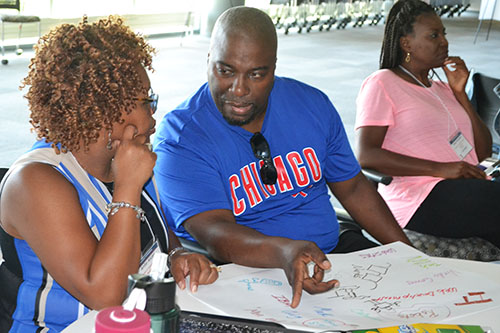
A team of educators discuss student perceptions of STEM.
According to Terry Koker, a chemistry teacher at Mahomet-Seymour High School the teaching on inclusiveness and self-efficacy was needed because it affects how schools plan. “How do you plan for 50-50 gender representation? How do you plan for not just targeting the top students?” he says. He reports that while his school has a lot of academic teams and clubs, they generally target the top 10% because they’re competing against other schools, “So you want to have your best students in that context. But this is not about competition. So I think that opens it up and to anybody that wants to participate.” Koker says his reason for participating in the institute was that his school is seeking 50-50 gender representation in its clubs.
According to Anita Alicea, the STEM Integration Specialist at the Sarah E. Goode STEM Academy in Chicago indicates that this year, they are beginning to implement culturally responsive teaching in their school. She says that based on Pollock’s teaching, she and her colleagues were thinking about, “‘What are things that we say that we actually don't realize that are insensitive to others?’ So I think the first thing that we need to do is make sure everyone understands what culturally responsive teaching is.” So her goal is to give them the language to make them aware. “Because as the professor said last week, ‘Now that you're aware, what are you going to do? What are your action steps?’” So Alicea says the first thing that they need to do is talk about the awareness with the 67 other teachers at their school.
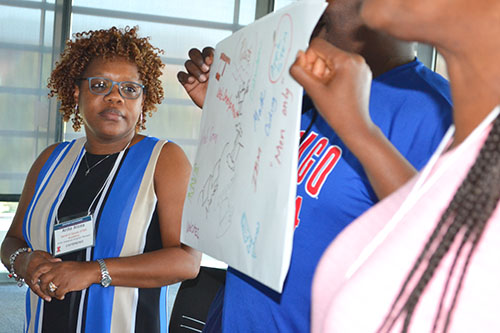
Anita Alicea, the STEM Initiatives Program Manager at the Sarah E Goode STEM Academy during her team's presentation of their poster about student perceptions of STEM.
Also, because Goode is partnered with Daley College as well, their students not only take classes at school, but at Daley as well. “So we want to make sure that our students, they actually can have self-efficacy for themselves so that when they're somewhere outside of Sarah E Goode, that they're familiar with what is happening to them and they can voice for themselves as well, making sure that they understand. And so if something is happening to them that they know and have the correct language to have that conversation with whomever it is that's causing them to feel not so right. So that's really where it starts. It's making people aware. And then our next step will be, ‘What will be our actions?’”
Similar to the schools and the challenges they are seeking to overcome, Pollock also faces a number of challenges in her line of work. For instance, one of the most challenging things about what she does is: “When you face a reticence from people to acknowledge that they play a role, unintentional or not, in the marginalization of students.” She adds that the current political environment has exacerbated the notion, which she says has manifested itself during her professional development workshops in some challenging ways.
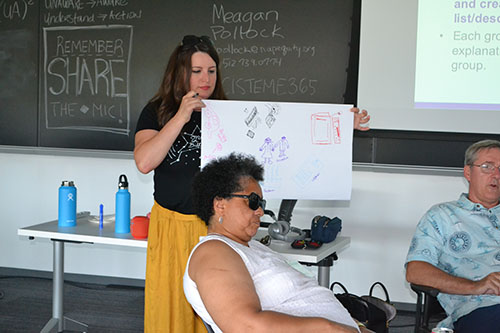
Irica Baurer, a Fine Arts Teacher at Sarah E. Goode STEM Academy, present's her team's poster.
“One of the challenges in this work is this: we're trying to create inclusive spaces, so you can't, you shouldn't shut anyone down. We’re trying to create spaces where everyone feels that they can contribute, yet you're still trying to push the needle along, and you're still trying to make everyone else feel included and safe. And so that's always the hardest thing: how do you create a space where everyone feels heard, but yet everyone still feels valued, and it's this constant negotiation; that's probably the hardest thing.”
What does she do when there's a conflict among people with opposing views? “It's sometimes hard to practice what I preach,” she confesses. First she asks questions to try to better understand, to get the person to unpack what it is that they are stating or claiming. In fact, she says a lot of times, the first words that you hear aren't actually what they meant. “So that's the first strategy, to keep asking questions: ‘Tell me what you mean by this?’”
She says the second thing is to not get defensive. She tries to be really aware of body language and what she’s signaling to the individual. However, when the individual is really wrong, she must address it.
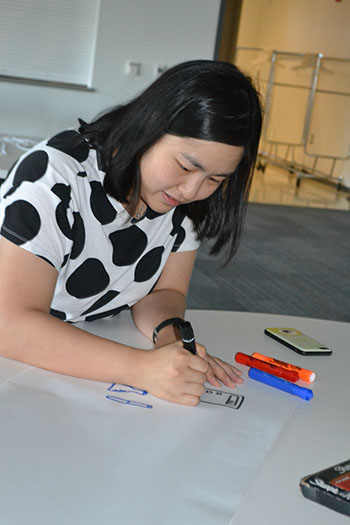
Elizabeth Ohr, a science teacher at Urbana High School works on her team's poster comparing what students think STEM is vs. what they think it requires.
“The flip side of it is, if something has ever been said or done and the environment is truly unfair or egregious, you have to say something, because silence is complicity,” she qualifies. “The challenge is negotiating, ‘How do I do this in the most protective way of that individual so that they still feel welcome, but she still makes everyone else who may be upset by the statement know that they are still valued and welcome.”
In light of the current political climate, she acknowledges that this is the kind of teaching that maybe folks besides teachers need to hear too: “We're trying to create more kind, empathic, understanding humans who allow others to be their true authentic selves and don't impose their values and don't impose their beliefs on them. That's really at the heart of what we're trying to do. We just put it in the context of student success.”
Pollock shares some of the success stories and “Aha moments” she’s experienced during her tenure conducting workshops. For instance, one Native American woman who had sat through her workshop in Albuquerque went on to create a whole program tied to the community college she worked at and targeting individuals from her tribe. The woman, who won a national award for the program, credits Pollock for her success: ‘This all happened because of what I learned in your workshops.’”
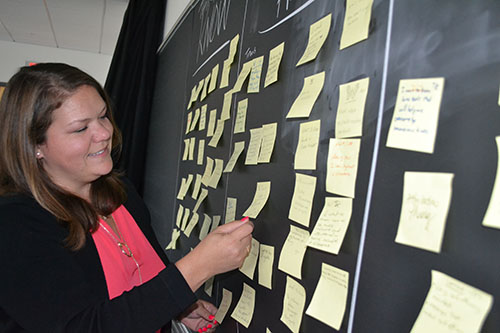
Meagan Pollock examines notes teachers posted on the blackboard regarding their aha moments during the training.
She has lots of other amazing examples of workshop participants who did some kind of intervention in their class and during a peer observation learned, ‘Wow, I had a bias I didn't know that I had! And now that I know it, I can be really intentional about mitigating the ways that that manifests in my classroom. And then they develop a higher awareness for that.’ And to me,” she admits, “that is just as much of a win, because this is a journey of a thousand steps. And if I can help one person begin to realize that they were looking at the world and their students in a different way than what they intended, then they can adjust that behavior. So that is equally powerful and wonderful to me.”
One reason Pollock is so effective in her work might be because she isn’t a hypocrite; she practices what she preaches: “This work is meaningful to me because it's my journey too,” she confesses. “I've come through so much and learned so much in this work. And I came from a place of having a really narrow and unkind view of people who are different than me, and I have worked to really understand how that has contributed to an unkind and equitable world. And so I'm working really hard alongside all of these people I'm working with, too. We're all on a journey, and we're never done.”
Story and photographs by: Elizabeth Innes, Communications Specialist, I-STEM Education Initiative.
More: CISTEME365, Electrical and Computer Engineering, Teacher Professional Development, 2019
For additional I-STEM articles about CISTEME365, please see:
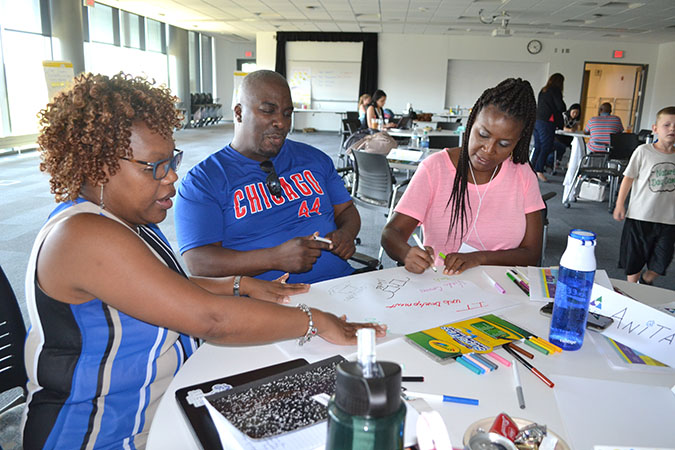













.jpg)
















